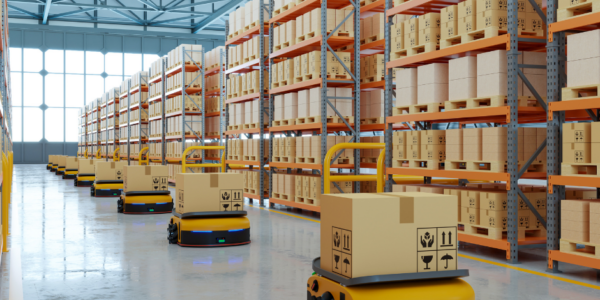Chain Store Age recently had a chance to visit one of Amazon’s Robotic Fulfillment Centers. They found that Amazon is not only automating, but also optimizing their systems. They begin by using AI to create demand forecasts that tell the company where to ship items for distribution. If they see that North Carolina is craving snack cakes, they’ll make sure that the distribution centers in North Carolina receive plenty of snack cakes.
Trucks are unloaded at the dock when they reach the distribution center, and the products begin their journey on 12 miles of conveyor belts. Nestled into totes, they head on one of those conveyor belts to a human-staffed post to be scanned into the system. When that’s done, the human places the item into a pod and it’s listed for sale on Amazon.com.
When the item is ordered, autonomous vehicles called rive carry them to a human. The human has a screen showing the product. They pull the product from the Drive , check it, and push a button to verify that they have the right item. They then put it into a tote and push it onto another conveyor belt.
This belt, armed with AI and an awareness of the product or products in the tote, routes the totes to the most appropriate packing station. This depends on the number of items in the tote, the size of the items, whether any item is fragile or requires special packing, etc. At the packing stations, a right-size box is automatically provided, and sometimes a perfectly-sized box is created automatically from cardboard. Shipping labels are slapped on and the packages are automatically sorted to go to the right station for loading.
Drive robots come back into the picture at this point. A package-sorting arm packs up the Drive vehicle until it’s ready to go. A blinking light alerts a human to push the cart to the right vehicle.
Worker safety
Chain Store Age was especially impressed by the emphasis on worker safety. Repetitive tasks, heavy lifting, and other tasks that ask a lot of human bodies are automated. People who work near robots have special vests that alert the robots that humans are nearby. The robots respond by stopping or slowing, depending how close they are to the humans.
Amazon, which has 750,000 robots in its workforce, has always insisted that the robots they use have a primary goal o increasing worker safety. Their new robotic fulfillment centers are designed to prevent workers from having to reach over their heads or squat down — all human actions can be taken in the sweet spot for easy reach. “Company data shows that, in 2022, recordable incident rates and lost-time incident rates were 15% and 18% lower, respectively, at Amazon Robotics sites than non-robotics sites.,” Amazon claims.
Check out some photos of the various robots used in the centers at Waredock or check out Amazon’s video on their robots:
